Shimane Museum of Ancient Izumo will be closed from April 2025 to September 2026 (tentative) due to seismic retrofitting and other renovation works.
Izumo no Kuni Fudoki
(1)The World of the Izumo no Kuni Fudoki
(2)Life in Ancient Izumo
(1)The World of the Izumo no Kuni Fudoki
This themed exhibition is based on the Izumo no kuni fudoki (Gazetteer of Izumo Province), a written collection of oral narratives compiled in the early eighth century as a report to the imperial court. The text describes the geography, natural resources, and local legends of the Izumo region. Historical records mention that gazetteers were compiled for each province, but the texts of only five provinces are extant today: Izumo, Harima, Hitachi, Bungo, and Hizen. Of these, only the Izumo no kuni fudoki survives in a nearly complete state.
Typically, representatives dispatched from the imperial court oversaw the compilation of gazetteers. Izumo’s text is exceptional, however, in that a regional lord handled its compilation. Reflecting this local expertise, the text records names for roughly 800 locations in the area, including the origins for many of them. The text also details the various plants and animals found in Izumo, as well as observations on its landscape, buildings, economy, and local customs. Today, this information provides valuable insight into daily life in ancient times.
Local myths are interspersed throughout the Izumo no kuni fudoki, and several of these stories are presented in “Myths of the Izumo Province,” a short film shown in the Mythology Theater adjacent to the Corridor of Myth and Legend.
(This English-language text was created by the Japanese Tourism Agency.)
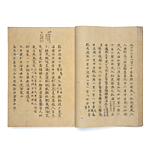
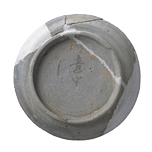
(2)Life in Ancient Izumo
The eighth-century Izumo no kuni fudoki (Gazetteer of Izumo Province) provides a rare glimpse into daily life in ancient Izumo. Among other details, the text contains extensive lists of the local agricultural and marine products. The “World of the Izumo no Kuni Fudoki” gallery has a life-sized diorama depicting a bustling riverside market. It was created based on information found in the gazetteer and other historical records.
Trade was conducted using rice or cloth as currency. In the exhibit, local inhabitants have gathered to peruse items at the market. One of the vendors is holding a Japanese sea bass (suzuki)—a prized product of ancient Izumo and a local specialty to this day. This fish also appears in the kuni-yuzuri (“relinquishing the land”) myth, where it is said to have been served at a banquet hosted by the deity Ōkuninushi no Kami.
A miniature diorama of an utagaki gathering shows how young men and women would meet near the bank of a stream to court each other by composing and reciting poems. An animated film in the gallery tells the fictional tale of a man and woman who meet at such a gathering. In some ways, ancient utagaki resemble the modern practice of gōkon, or organized group dating, where singles get to know one another over food and drinks.
(This English-language text was created by the Japanese Tourism Agency.)
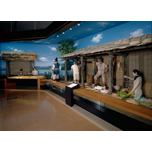
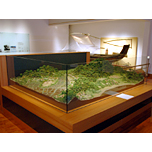
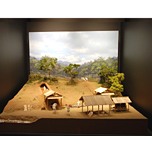
|
Shimane Museum of Ancient Izumo 99-4 kizuki-Higashi, Taisha, Izumo City, Shimane Prefecture, 699-0701 JAPAN TEL +81-853-53-8600/FAX +81-853-53-5350 | Copyright © 2007 Shimane Museum of Ancient Izumo. All rights reserved. |
